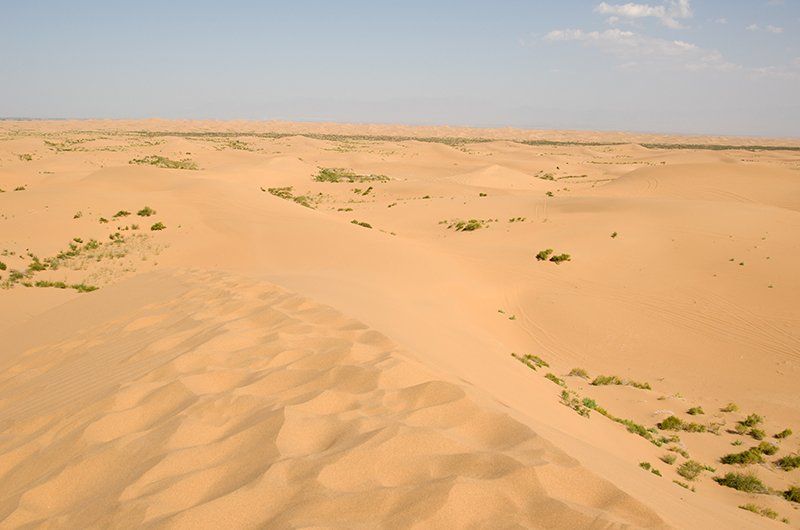The Stones of the Gobi Desert, Part 1Introduction to the Stones of the Extensive Gobi Desert
By Thomas S. Elias, November, 2013
The extensive and thriving viewing stone industry in China is fueled, in part, by the recognition that the Gobi Desert has numerous types of stones that are highly regarded in viewing stones communities throughout China, and partly because the Gobi region has huge quantities of stones to supply the growing domestic demand. Gobi Desert stones have quickly risen to the top of the most desirable stones in China just within the last two decades. Some Gobi stones are now among the most expensive viewing stones in China today.
It is essential to understand some basic physical features of the Gobi Desert in order to appreciate Gobi Desert viewing stones. This is a vast desert and semi-desert region, oriented in a southwest to northeastern position and extends for approximately 1,600 km (1,000 miles) and nearly 800 km (500 miles) wide from north to south. ‘The Gobi is experiencing a period of rapid expansion due to multiple factors including over-grazing, land-use practices, and climate change. It is a cold desert and semi-desert located on a raised plateau that ranges from 910-1,500 meters (2,900 to nearly 5,000 feet) in elevation. The climate is continental with extremes in the summer and winter, and even during a single day. Contrary to some beliefs, the Gobi Desert consists mainly of exposed rocky areas and strongly eroded, ancient mountain ranges and extensive basins that may have been huge ancient lakes. Sand dunes are prevalent in various regions but comprise a minority of the area.
The Gobi is rich in mineral deposits, particularly copper and gold. It is rich is siliceous rocks and minerals, such as different types of quartz. Quartz comes in two basic groups—the crystalline group with different types of large crystals, and the cyptocrystalline group that has microscopic crystal whose individual crystals are too small to be seen by the human eye. Both groups occur in the Gobi Desert, but the latter group makes up 95% of the stones sold in the viewing stone markets of northern China. In mineralogical terms, these are classified as different varieties of chalcedony. According to the well-known mineralogist, John Sinkankas, chalcedony is a term used for microscopic quartz crystals that are massed in parallel position, forming dense wax-like masses. Some of the better known varieties of chalcedony are carnelian, agates, chrysocolla, onyx, jasper, chert, and replacements of wood, shells, bones, and other organic matter with silicon dioxide. Petrified wood from the western Gobi is an example. Thus, Gobi Desert viewing stones have shared or common features in that they are formed from crystalline silica. This explains why Gobi stones are typically very hard and difficult to modify, unlike the softer carbonate stones found in southern China.
There are three cities with permanent stone markets that feature Gobi Desert stones. The western-most location is Urumachi in Xinjiang Uygur Autonomous Region. The eastern-most city is Yinchuan in Ningxia Hui Autonomous Region and the third--and the most important one--is Alashan in the Inner Mongolian Autonomous Region. Alashan has grown rapidly in the last ten years to become the stone capital of northern China. Visits to the stone markets in these cities will allow you to see the wide range of Gobi stones.
Common types of stones seen in markets:
Chalcedony stones are very common in the Gobi Desert. These stones are often colorless or may be pale gray or pale blue. These assume a wide variety of shapes and colors. Those that resemble people, animals, and even food are sought after in markets.
Agates, individual and botryoidal (grape-like clusters), are banded chalcedony and are less common than typical non banded chalcedony stones. Grape agates are rare and available in a very limited supply; thus, they have become one of the more expensive types of Gobi Desert stones. This is especially true if the aggregates have a shape that resemble a person or animal. Colored grape aggregates or multi-colored grape ones command very high prices. Another important factor is the size of the individual grape-like structures. The larger the spheres, the higher the price.
Moss agates are semi-translucent and have moss-like formations of manganese oxides or other minerals within the stone; these are not commonly seen.
Jasper type stones are opaque to sub-translucent chalcedony, are smooth, and contain finely divided clay and iron oxides, often giving them a dark brown to reddish-brown color. Dark green jasper is also occasionally seen.
Replacements (petrified wood, bone, & shells) are regularly seen in markets, although some of these are brought from Mongolia and Myanmar. The shape of the pieces is important. One with interesting shapes, including those with branches, nodes, or portion of roots, are more valued. The color, surface texture, and finish are also important in determining the quality of a replacement stone.
(to be continued in next update)


